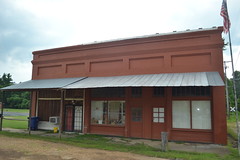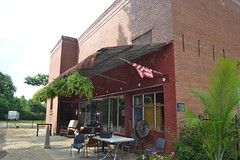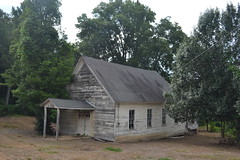
One of the cooler things about building renovations is that sometimes they uncover pieces of history, such as old plaques or advertising signs. Such was the case with the building being converted into residences next to the Webster Avenue Stage in Memphis’ River Arts Fest. I had been standing beside it for a couple of hours or so, and hadn’t noticed anything about it, but when the afternoon sun hit it a certain way, I could clearly make out an old sign: “Chero-Cola Bottling Company.” What on earth was Chero-Cola, I wondered? As it turns out, Chero-Cola, founded by a grocery store owner in Columbus, Georgia in 1915 was the predecessor to the far better-known Royal Crown Cola, or RC, the beverage that went with a moon pie in the Southern past. The founder was trying to find a replacement for Atlanta-based Coca Cola when the Columbus distributor for the latter refused to give him a volume discount he felt he deserved. Although the first Royal Crown beverages appeared earlier (a ginger ale and a root beer), Chero-Cola (did it perhaps include cherry flavoring in the formula?) first appeared in 1915, and only lasted through about 1921, when a court ruled that the designation “cola” could only be used by Chero-Cola’s famous competitor, Coke. Without being able to designate their signature drink as a cola, sales flagged, and the company was renamed from Chero-Cola to Nehi. By the time it introduced a new cola formula in 1933, the name had been changed again to Royal Crown or RC. A court in 1944 overturned the old 1921 decision, and RC’s became officially “colas” again. But the coolest thing is that the relatively-short time that Chero-Cola existed helps us place the Memphis building in time between the years 1915 and 1921. A really cool discovery indeed!
Architecture
Highway 51 Revisited: Forgotten Towns in North Mississippi
Abandoned, Architecture, Blues, Education, ghost towns, History, Night Clubs, Photography, Schools, Travel

















During the 1960’s, the new interstate highways began to bypass the old US highways and the towns along them, and gradually these towns began to fade into obscurity. But a trip along the old highways can be extremely rewarding, revealing ghost towns and historic buildings. On last Friday, August 1, I decided to make my trip to Jackson along Highway 51 from Batesville, and found some interesting and intriguing places. The tiny town of Pope, Mississippi in Panola County, aside from residences, was mainly one street along the railroad with a couple of old historic buildings, one of which had been turned into a restaurant called The Place, that looks as if it might warrant further investigation. But I was especially impressed with the town of Enid, from which Enid Lake draws its name although the lake and the town are in different counties. The town, in Tallahatchie County, seems barely above ghost town status these days, but its only remaining downtown building is now a performance space known as the Enid Music Hall, which features live music on weekends, often blues. On the other side of the railroad tracks was a very old wooden church, which certainly appears to be historic, although there is no historic marker. A sign on the building is rusted, but I could still make out that the building had been the Bethany Baptist Church. A nearby building looks as if it had been a one-room school, or perhaps an education building for the church. Down the road just below the city of Oakland, Mississippi, I came upon a large, abandoned school complex along Highway 51. With no signage there, I had no way of knowing what school it was, but I never fail to see these abandoned schools in Mississippi and Louisiana without being depressed. After all, these are poor states with great educational needs, and to see these taxpayer-funded investments rotting away in the Mississippi sun is not a good look at all.
The Lower End, Front Street, Mason TN, Summer 1991
Architecture, PhotographyMason, Tennessee, Front Street, The Lower End, Summer 1991.
You must be logged in to post a comment.